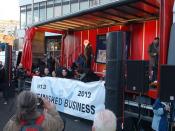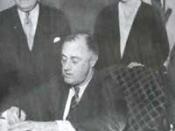Labor Relations Paper
Human Resources Management
January 9, 2009
�
�
Labor Relations Paper
Unions may reduce a business's flexibility and economic performance, which are a proposition collected from the agreement of other previous propositions, from the suffering of other individuals who were endured in the past. It took time before unions were develop and as people started working for unions in different types of companies, competent in protecting their rights and that their employers would not treat them maliciously or unjustly. Although the right to collective bargaining took nearly 200 years in the United States, collective bargaining rights are held in nearly every country today (Kearney, 2007).
Collective bargaining is a part of the negotiation process's that will have a result of a contract that will cover all employee conditions. The most common employment conditions covered in the contract include compensation, hours, and working conditions. But the contract can include any issue that both sides agree upon.
In today's society, job security is a major bargaining issue for unions.
Contract Negotiation
Every contract is the products of negotiations among employees and managers. Contracts are generally writing presented in legal, uninteresting stipulations although they are extremely vital for securing the rights of workers in the workplace, should one chose to negotiate a contract at all. Contracts symbolize the least amount of benefits and compensation for workers, in accordance with labor law (Kearney, 2007). An employer can propose benefits and rights that - the least standards set in an existing contract. All employees in organizations must know the terms of their contract, because managers frequently will try to go against contracts. For this reason, employees choose shop stewards and negotiate grievance procedures. If the employee does not stand up for his rights, the employer can succeed in undermining the contracts.
Strikes
A strike is a collective choice of the members of the union not to work awaiting certain demands or conditions are met. The union member vote, and if the majority favors a strike, all union members go on strike at that time or when union leaders believe the time is right. Strikes are normally accompanied by picketing - the union places members close to the workplace with signs representing the union is on strike (Kearney, 2007). Union members do not receive pay from their employer during the strike, but the union might be capable to make up for some of the lost pay. If the employer cannot hire substitute employees during the strike, the employer loses production.
Arbitration
To avoid a strike or lockout (refusing to let employees work) and to handle grievances by either side, collective bargainers sometimes agree to use neutral third parties, called mediators, from the Federal Mediation and Conciliation Service. A mediator is someone will be neutral parties that will help settle disagreements during negotiations. In which cases where management and labor are not willing to be a team but do not want to call a strike or lockout, they may call in an arbitrator. An arbitrator is different from a mediator in that the arbitrator makes a binding decision for management and labor. The arbitrator's decision must be followed. The service of an arbitrator is more commonly used to settle grievances than to deal with impasses in collective bargaining (Arbitration Act, 1996).
The two types of arbitrators are labor arbitration and employee arbitration, which are very different. Labor arbitration is a process involving two equals. The union and the employee both choose and compensate the arbitrator. Both sides use qualified advocates who understand the process and the facts of a particular case. Employment arbitration pits an unaware individual against the resources of a business. Labor arbitrators tend to have some stability in their decisions because they know that both sides have to trust their impartiality if they are to be chosen to arbitrate (Arbitration Act, 1996). In employment arbitration, the employer will most likely pay all expenses of arbitration.
Grievance Handling
When dealing with a grievance, individuals are required to be familiar with the process and apply the procedure correctly. Grievances must be dealt with sensitively, particularly in which they concern other employees. One might desire to develop specific procedures for extremely sensitive matters concerning inequitable treatment such as discrimination, bullying, or harassment. Additionally, one may wish to develop a separate "whistle blowing" procedure. By doing so, employees are encouraged to raise any complaints about misconduct such as fraud, internally rather than disclosing them outside to organization. By dealing with problems in a fair and realistic approach, employers are less likely to lose valued and skilled employees through resignation (California Faculty Association, 2007). Additionally, treating problems fairly and reasonable can help successfully defend a positive dismissal claim.
Union Campaign
To react positively or favorably to all demands of a union campaign to demand a fast and a well organized plan by the experts in the labor relations department. Effectively being engaged in the union's campaign entails the forming and execution of the infrastructure strategy planned for influencing a majority of workers participating in the election to choose not in favor of representation by a union. Union organizing campaigns are typically embedded on the inside, not on the outside, and can be evaded by recognizing issues. After all, the most effective guarantee for avoiding unionization is addressing all the issues in the beginning the union is recognizing certain practical issues (Mason, 1991).
Labor relations are the management specialty emphasizing skills that managers and union leaders can use to minimize costly forms of conflict and to seek win-win solutions to disagreements. Labor relations are the median union employees and the management. Labor relations are also called union-management relations and industrial relations. There are many more organizations without unions than there are with unions. Therefore, not all organizations have labor relations as part of their human resources systems. The union is an organization that represents employees in collective bargaining with the employer. Unions are also a source of recruitment. The National Labor Relations Act, which is also known as the Wagner Act was established by the National Labor Relations Board. The National Labor Relations Board oversees labor relations by conducting unionization elections, hears unfair labor practice complaints, and issues injunctions against offending employers (Mason, 1991).
Organizations that recognize the suitable employee relation's policies, strategies, and practices will have an optimistic effect on the employee behavior. There is organizations that recognize the competitive advantage and benefits that these modifications are capable of complimenting the entire accomplishment of the business. A key change in organizational strategies includes a more flexible work policies and structure such as telecommuting, flexible work hours, and dress code. Another key change in organizational strategies is the increased sensitivity to the differences in age in the employee relation policies, recruitment, and employee improvement is another key change in organizational strategies. Additionally, front-line supervisory education and growth have increased (Anner, 2001).
Changing workers demographics has determined the requirement for organizational modification throughout the United States. Today, additional women are entering and remaining in the labor force. In the country's workforce today, approximately 49% comprises women. Additionally because of technology, cultural diversity is increasing in businesses across the nation. In today's society, cultural diversity is worldwide. Policies and strategies of employee relation have to develop to take these demographic changes into account (Anner, 2001).
In today's society, unions are still relevant. There will still be a need and desire for unions several organizations today than there were in the 1900s. The working class in the US wants to know if unions will continue to change the development and improvement between management and the employees to conform to the global economy, the field that most people went to work in the United States is retail and not manufacturing.
References Barry J. Kearney, 2007, National Labor Relations Basic Law and Procedures (2007).
www.abanet.org/labor/basics/nlra/kc_home.shtml The Federal Labor Relations Authority.
www.flra.gov
Handling Grievance and Discipline Procedures.
www.is4profit.com/businessadvice/grievance_discipline/10_handling
Arbitration Act 1996 (1997).
www.hmso.gov.uk/acts/acts1996/1996023.htm CFA Grievances and Arbitrations, August 28 2007
www.calfac.org/grievances.html
Orson Mason, September, 1991.UFCW, Wal-Mart Anti-Union Materials
www.ufcw.org ⺠... ⺠Wake-Up Wal-Mart ⺠Resources - Cached - Similar
History of labor union. 1 March 2007. History of labor union www.socialstudieshelp.com/eco_unionzation.htm
Anner, Mark, 2001. The international trade union campaign for core labor
www.faqs.org/.../The-international-trade-union-campaign-for-core-labor-standards-in- the-WTO.html - Cached


